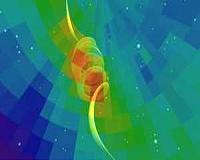|
 Cassini Catches Saturn Moons In Paintball Fight
Cassini Catches Saturn Moons In Paintball FightPasadena CA (JPL) Oct 08, 2010 Scientists using data from NASA's Cassini spacecraft have learned that distinctive, colorful bands and splotches embellish the surfaces of Saturn's inner, mid-size moons. The reddish and bluish hues on the icy surfaces of Mimas, Enceladus, Tethys, Dione and Rhea appear to be the aftermath of bombardments large and small. A paper based on the findings was recently published online in the journal Icarus. In it, scientists describe prominent global patterns that trace the trade routes for material ex ... read more |
. |
|
|
Free Space, Earth, Energy And Military Newsletters - Delivered Daily |
| . | . |
| .. |
Cluster Helps Disentangle Turbulence In The Solar Wind Washington DC (SPX) Oct 05, 2010
Washington DC (SPX) Oct 05, 2010From Earth, the Sun looks like a calm, placid body that does little more than shine brightly while marching across the sky. Images from a bit closer, of course, show it's an unruly ball of hot gas that can expel long plumes out into space - but even this isn't the whole story. Surrounding the Sun is a roiling wind of electrons and protons that shows constant turbulence at every size scale: ... more Missions, Meetings, And The Radial Tire Model Of The Magnetosphere  Greenbelt MD (SPX) Oct 05, 2010
Greenbelt MD (SPX) Oct 05, 2010Goddard scientist Tom Moore has recently been named Project Scientist for the Magnetospheric MultiScale mission (or MMS), four spacecraft that will launch in 2014 to study "magnetic reconnection" - a crossing of magnetic field lines that can produce solar flares as powerful as a billion atomic bombs and is responsible for magnetic storms and auroras in Earth's atmosphere. Tom's primary res ... more Solar system's shield is showing cracks  San Antonio (UPI) Oct 2, 2010
San Antonio (UPI) Oct 2, 2010 The outer boundary of the solar system is more dynamic and complex than ever imagined, astronomers said. The Interstellar Boundary Explorer satellite, launched two years ago, is studying the heliosphere, the invisible bubble far beyond the planetary orbits where the solar wind meets the particles and radiation that fill interstellar space, researchers told the Los Angeles Times. ... more |
.. |
 'Hot water' life found in Wyoming lake  Knot In The Ribbon At The Edge Of The Solar System "Unties"  Instant online solar energy quotes Solar Energy Solutions from ABC Solar |
.. |
|
|
Free Space, Earth, Energy And Military Newsletters - Delivered Daily |
|
|
. |
 Backward Orbit In A Binary System
Backward Orbit In A Binary SystemArlington TX (SPX) Oct 04, 2010 Work by a team of University of Texas at Arlington astronomers could significantly broaden astrophysicists' search for planets in other solar systems by changing the way they think about the orbiting bodies. If correct, the findings could increase the opportunities for the discovery of new planets in candidate systems. The paper by Manfred Cuntz, UT Arlington associate professor of physics, and Jason Eberle, a doctoral candidate from UT Arlington, was published in the American Astronomical S ... read more |
| The contents herein, unless otherwise known to be public domain, are Copyright 1995-2010 - SpaceDaily. AFP and UPI Wire Stories are copyright Agence France-Presse and United Press International. ESA Portal Reports are copyright European Space Agency. All NASA sourced material is public domain. Additional copyrights may apply in whole or part to other bona fide parties. Advertising does not imply endorsement, agreement or approval of any opinions, statements or information provided by SpaceDaily on any web page published or hosted by SpaceDaily. Privacy statement |
| Previous Issues | Oct 07 | Oct 06 | Oct 05 | Oct 04 | Oct 01 |